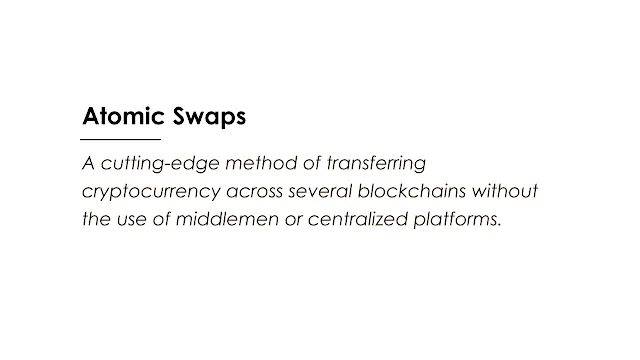 |
| Image: Moneybestpal.com |
Atomic swaps are a cutting-edge method of transferring cryptocurrency across several blockchains without the use of middlemen or centralized platforms. Without having to rely on a third party or run the risk of losing their money in the event of a hack or security breach, they enable users to trade tokens directly with one another.
Since they allow transactions between various blockchains that might not be compatible otherwise, atomic swaps are also referred to as cross-chain atomic swaps.
However, atomic swaps also face some challenges and limitations, such as:
How do atomic swaps work?
Hashlocks and timelocks are two essential cryptography methods used in atomic swaps. A hashlock is a condition that prevents a transaction from being completed without the disclosure of a preimage, a secret value. A timelock is a condition that prevents a transaction from being unlocked until a predetermined period of time has passed or a predetermined block height has been reached.
Let's use the example of Alice and Bob, who want to trade 15 ETH for 1 BTC, to show how atomic swaps operate. They agree on using an atomic swap protocol that involves the following steps:
- Bob creates a hashlock by generating a secret value and hashing it. On the Bitcoin blockchain, he then constructs a smart contract that locks 1 BTC and stipulates that Alice can claim it if she discloses the hashlock's preimage within 24 hours. In any other case, after the timelock ends, Bob will get his BTC back.
- Alice receives the hashlock from Bob, and she confirms that the smart contract is present on the Bitcoin blockchain and that it complies with the agreed-upon terms.
- On the Ethereum blockchain, Alice launches a smart contract that locks 15 ETH and stipulates that Bob can claim it if he discloses the same preimage of the hashlock within 12 hours. If not, after the timelock expires, Alice will receive her ETH back.
- Bob receives the smart contract address from Alice and confirms that it is real and adheres to the agreed terms.
- By divulging the preimage of the hashlock, Bob is able to claim the 15 ETH from Alice's smart contract. Additionally, Alice is now aware of the preimage, which she can use to obtain the 1 BTC from Bob's smart contract.
- Both parties successfully performed the atomic swap and received the tokens they wanted.
What are the benefits and challenges of atomic swaps?
Atomic swaps have several benefits over traditional methods of exchanging cryptocurrencies, such as:- Decentralization: Atomic swaps do away with the need for centralized exchanges or escrow services, which may set restrictions, levy fees, censor transactions, or experience hacks or outages.
- Security: Smart contracts and cryptographic proofs are used in atomic swaps to guarantee that both parties will fulfill their obligations or receive their money back. There is no chance of losing money to theft, fraud, or human error.
- Privacy: Users using atomic swaps are not required to divulge their identities or personal data to one another or to any other parties. Additionally, since just the transactions for locking and unlocking are recorded, they do not leave any evidence of the swap on either blockchain.
- Interoperability: Cross-chain transactions between several blockchains are made possible by atomic swaps, which may not have inherent compatibility or communication channels. Users can access a greater variety of tokens and liquidity pools thanks to them as well.
However, atomic swaps also face some challenges and limitations, such as:
- Complexity: Atomic swaps call for the creation and verification of smart contracts on both blockchains, as well as mutual agreement on the exchange rate, hashlock, and timelock parameters. Technical expertise and knowledge may be required, which not all users may have.
- Liquidity: Atomic swaps are dependent on the presence of matched orders from other users who want to swap the same tokens at the same rate and time. For less well-known or specialized tokens, in particular, this might not always be simple to locate.
- Compatibility: Both blockchains must feature hashlocks, timelocks, and smart contracts or equivalent functionality in order to facilitate atomic swaps. These properties and how they are used vary amongst blockchains.
- Speed: The confirmation timeframes and transaction costs of the two blockchains participating in the swap will affect atomic swaps. Delays or expenses resulting from this could have an impact on the swap's viability or profitability.
The future of atomic swaps
Atomic swaps are a still-emerging technology that is being explored and enhanced by numerous initiatives and communities in the cryptocurrency field. Some of the current developments and innovations include:
- Lightning Network: a layer-two solution that permits quick and affordable off-chain atomic swaps between Bitcoin and additional cryptocurrencies that adhere to the same protocol, including Litecoin, Decred, and Vertcoin.
- Submarine Swaps: A method that uses a third-party service that serves as a swap provider to let users swap tokens between an on-chain address and an off-chain address on the Lightning Network.
- AtomicDEX: A decentralized exchange platform that uses the Delayed Proof of Work (dPoW) cross-chain protocol to facilitate peer-to-peer atomic swaps between any two cryptocurrencies supported by the Komodo ecosystem.
- Thorchain: A decentralized liquidity network that allows for cross-chain atomic swaps using the Threshold Signature Scheme (TSS) cross-chain protocol between any two cryptocurrencies supported by the Cosmos ecosystem.
A promising technique called atomic swaps has the potential to improve the efficiency, interoperability, security, and privacy of cryptocurrency exchanges. Additionally, they can provide users additional authority and control over their digital assets and transactions. Atomic swaps might wind up being a normal aspect of the bitcoin ecosystem as the technology develops and becomes more widely available and user-friendly.
